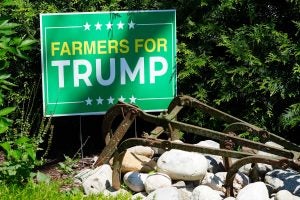Food production has long been central to politics, and the 2016 presidential race showed everyone just how vital the agricultural industry and rural America are to the election.
It’s shaping up to be a barn-burner of a 2020 presidential election in more ways than one, as yet again the nation’s agricultural states look to pick the winner of the U.S. presidential race. With the polls running tighter than the margins on double-cropped soybeans, the Electoral College will undoubtedly be where the decision is made to either re-elect President Donald J. Trump (GOP), or replace him with former Vice President Joe Biden (Democrat), Libertarian Jo Jorgensen, or Green Party Howie Hawkins. And while the popular media focuses on the COVID-19 pandemic and social issues as a defining interest among voters in rural areas, the fact is, agri-business matters.
As a group, farmers across the country gave Trump the nod in 2016. But as a group, they’re reporting mixed feelings as the summer creeps into fall this 2020. Trade battles with China and Mexico that commenced almost at the onset of the Trump administration shook soybean producers and dairy farmers from the start, as those two nations count as their largest customers. Crackdowns on immigrant labor, another staple of the ag-economy these days, also hit home, and as the New Year rolled from 2019 to 2020 producers had yet another unforeseen crisis — COVID-19. The American Farm Bureau Federation details how disrupted supply chains due to shutdowns have shattered farmers’ year, and little is known about the immediate future of food demand considering the number of public schoolchildren who won’t be eating lunch in schools this fall.
That said, the Trump administration has brought record volumes of direct and indirect aid to farmers, spiking from $11.5 billion in 2017 to $32 billion in 2020, both in bulk product purchases and direct checks to farms, increasing each year of his administration. Meanwhile, small farmers, particularly those growing table crops such as fruits and vegetables, have reported that these programs are primarily aimed at larger corporate farms rather than small and medium-sized.
And, Democrats have been watching. Biden’s team has included farm aid into its proposed $2 trillion environmental plan, chock full of proposals for young and small farmers, and concerns for larger producers who fear they might fall into the traps of new regulations.
The boil-down, many in the industry feel, is that Trump’s Republicans are better for big, corporate farmers, while Biden’s Democrats may be better for the smaller producers. Meanwhile, the Green and Libertarian parties offer ideological bookends to the debate, with the former advocating a sweeping set of environmentally conscious principles directly almost squarely at agriculture, and the latter arguing for a complete withdrawal of federal regulations and support for the industry, period. In the end, issues do matter, and here’s where the candidates stand to date.

2020 Republican Party Candidate — President Donald Trump
Bio: Incumbent President Donald J. Trump is a graduate of the Wharton School of Finance and has spent his business and television career dreaming big and pushing the boundaries of what is possible, according to his campaign website. His campaign slogan when he was elected in 2016 was “Make America Great Again,” and this election cycle, his slogan is “Keep America Great.” Trump’s running mate is incumbent Vice President Mike Pence.
Here’s where the presidential candidate stands on key issues related to the agricultural industry:
Trade: In terms of trade policy, the Trump administration offers to continue with its staunch America First initiative and fight for a higher volume of exports, particularly in the field of agriculture. The campaign points to its Phase One Agreement signed into effect with China, which not only required significant structural changes to trade, but also levied tariffs on $370 billion worth of imports from that nation. Trump also credits as a big win his replacement of the North America Free Trade Act (NAFTA) with the United States-Mexico-Canada Agreement (USMCA), which he argues expands market access for American agriculture exports to both neighboring countries. Another claimed win by the Trump team is his United States-Japan Trade Agreement which states that more than 90 percent of U.S. food and agricultural products imported into Japan will be either duty-free or receive preferential tariff access. In terms of global trade in general, the Trump administration expresses the desire to continue a complete reworking of the World Trade Organization (WTO) with an American-first perspective.
Immigration: The Trump campaign plans to keep on the same track as it’s been from the beginning. Upon entering office, Trump called upon Congress to fund construction of a wall along the nation’s southern border with Mexico, and close legal loopholes that enable illegal immigration, end chain migration, and eliminate the visa lottery program. The administration plans to continue its work to wind down the Deferred Action for Childhood Arrivals (DACA) and transition to a merit-based immigration plan.
Infrastructure: The Trump administration has outlined a proposed $1 trillion infrastructure plan aimed at rebuilding bridges and roads, as well as advancing rural broadband and 5G wireless. This is a possible boon for the agricultural community, a good portion of which struggles for Internet connectivity and is becoming more reliant upon high-tech tractors and smart implements.
Rural Communities: The true electoral battleground upon which President Trump will either win or lose his office, rural Americans turned out in droves for him in 2016. But as the election nears, the question will be one of keeping them. The historic quarantine of 2020 due to COVID-19 has run many small businesses in rural America down hard, but likewise, record volumes of stimulus funds have been sent to affected workers. In terms of rural communities, the Trump campaign has focused primarily on addressing the closures and re-opening of businesses, and maintained on its track of conservative social issues.
Crop Subsidies: Government payments to farmers have skyrocketed to historic levels under Trump as the administration has spent to spare America’s ag-producers the full measure of ill effects of tariff fights and the COVID-19 shutdowns. Direct farm aid has climbed each year of the Trump presidency from $11.5 billion in 2017 to more than $32 billion in 2020. Going forward, the Trump team is calling yet more funding to go directly to farmers and their ag-industrial suppliers.

2020 Democratic Party Candidate — Former Vice President Joe Biden
Bio: Joe Biden was born in Pennsylvania and moved to Delaware as a boy. In 1973, at age 29, Biden became one of the youngest people ever elected to the U.S. Senate. He was in that role until 2009, when he became vice president for the eight years Barack Obama served as president. Biden’s running mate is Kamala Harris.
Here’s where the presidential candidate stands on key issues related to the agricultural industry:
Trade: As part of Biden’s proposed initiative, trade policy with foreign partners is a priority. Noting that more than 20 percent of all crops grown in the U.S. are exported, the Biden team supports working with allies to renegotiate trade agreements with China and Mexico as opposed to hard tariffs from a unilateral position. The Biden proposal also plans to strengthen antitrust enforcement by way of the Sherman and Clayton Antitrust Acts and the Packers and Stockyards Act. As the former vice president under Obama, Biden is arguing for a continuation of that administration’s trade policies.
Immigration: The Biden administration would take immediate action to undo the Trump administration’s policies regarding construction of a wall between the U.S. and Mexico, as well as policies that separate families at the border. Biden has pledged to reassert the country’s commitment to asylum-seekers and refugees and tackle root causes of irregular migration. Referencing the Obama-Biden legislative package designed to address immigration reform in 2013, the campaign has pledged to re-examine relationships and activities in Central American nations as part of a plan to stave off the violence that has sent refugees here, while opening the doorway for seasonal farm labor and migrant workers.
Infrastructure: As part of Biden’s proposed $2 trillion infrastructure initiative, the Democrats hope to generate jobs in rural America by way of roads and bridgework, as well as in climate-smart agriculture, resilience, and conservation. This proposal aims for 250,000 jobs plugging abandoned oil and natural gas wells and reclaiming coal, hard rock, and uranium mines. The Biden team also plans to focus intently on green energy and fuel sources, which offers hope for those ag-industries involved in solar farms or bio-fuels. The advancement of sustainable agriculture and conservation is a stated priority.
Rural Communities: The Biden campaign’s plan for rural America is one of revitalization along the lines of technology and funding, with the overarching goal of partnering with farmers to make American agriculture first in the world to achieve net-zero emissions. With plans to expand the Obama-Biden Administration’s microloan program for new and beginning farmers, the campaign hopes to double the maximum loan amount to $100,000 and increase funding for the U.S. Department of Agriculture’s farm ownership and operating loans. The development of better regional food systems is another target of Biden’s, with the goal of getting more small and mid-sized farmers involved in delivering food to institutions and the U.S. Department of Defense. Re-investment in land grand universities’ agricultural research programs is another target, including the Sustainable Agriculture Research and Education Program, and the National Institute of Food and Agriculture, as well more access to rural broadband Internet.
Crop Subsidies: The Biden campaign seeks to an expansion of existing conservation programs aimed at paying farmers to adopt a growing number of environmentally friendly practices and help sequester carbon within the soil. In terms of subsidy programs, he has specifically stated his goal is to help small and medium-sized growers against larger corporate competitors who have been perceived to have benefited most from the Trump administration’s programming.

2020 Libertarian Party Candidate — Jo Jorgensen
Bio: Jo Jorgensen is a senior lecturer in psychology at Clemson University. She holds a Ph.D. in Industrial/Organizational Psychology (Clemson, 2002) and has taught full-time since 2006. She graduated in 1979 from Baylor University with a B.S. in Psychology and in 1980 from Southern Methodist University with an MBA. She has previously served as her party’s vice presidential nominee. Jorgensen’s running mate Spike Cohen.
Here’s where the presidential candidate stands on key issues related to the agricultural industry:
Trade: Stating that, “The freedom to trade and travel are fundamental to human liberty. As Americans citizens, we should be free to travel anywhere we choose, and to buy and sell anywhere in the world.” Libertarian candidate Jorgensen is pledging that, if she were the first U.S. president elected from her party, she would work to eliminate all trade barriers and tariffs, as well as repeal quotas on the number of people who can legally enter the U.S. to work, visit, or reside.
Immigration: In keeping with Libertarian Party philosophy, Jorgensen seeks to remove all federal regulations determining immigration status and allow free market forces to determine who comes and goes across U.S. borders.
Infrastructure: Jorgensen has pledged to veto any spending bill, infrastructure-related or otherwise, which would lead to a deficit, and veto any debt ceiling increase. Given that the present U.S. National Debt is nearly $27 trillion, that means little to no additional infrastructure funding.
Rural Communities: Jorgensen’s Libertarian campaign doesn’t directly address “rural communities” per se, but it does tackle the issue of poverty directly. Stating that the cure for poverty is a vibrant economy, Jorgensen’s position is that between 1959 and 1969 the poverty rate was cut nearly in half without government intervention, and yet in 2020, after nearly 50 years of federalized anti-poverty programs, the rate remains unchanged. The Libertarian platform is aimed reducing taxes and regulations, including those on rural businesses and the ag industry, which they feel are stifling growth.
Crop Subsidies: Jorgensen’s position is that the federal government should end all crop and energy subsidies, reduce taxes and regulations, and allow these organizations to grow at a market pace.

2020 Green Party Candidate — Howie Hawkins
Bio: Howie Hawkins is the original Green New Dealer, the first U.S. candidate to campaign for a Green New Deal in 2010. He is also one of the original Greens in the United States, having participated in the first national meeting to organize a U.S. Green Party in St. Paul, Minnesota in August 1984. His running mate is Angela Walker.
Here’s where the presidential candidate stands on key issues related to the agricultural industry:
Trade: The Hawkins campaign is calling for a complete replacement of the World Trade Organization, International Monetary Fund, and World Bank, with new institutions accountable to citizens of all nations. A complete re-formulation of all U.S. international trade relations and commerce as currently upheld in favor of local agriculture and industry over foreign corporations. The Green Party also seeks to re-write the rules of investment of corporate capital in projects overseas to guarantee the rights of citizens in those nations and their access to public ownership and control of their own resources.
Immigration: The Green Party lays the blame for current immigration debates squarely on trade practices they call unfair and that make work in the U.S. preferable to the home countries, agriculture included. Hawkins’ campaign seeks as a goal a world in which people could work or live in any nation of their choice, ever bearing in mind that requires multi-lateral cooperation among the nations.
Infrastructure: To a large degree, the Green Party platform is based on principles involving environmental approaches to infrastructure. The Green Party’s 10 Key Values are: Grassroots democracy; social justice and equal opportunity; ecological wisdom; non-violence, decentralization; community-based economics; feminism and gender equity; respect for diversity; personal and global responsibility; and future focus and sustainability. With that in mind, sweeping reform in terms of renewable energy and regulations designed to offset climate change are the overall thrust of this campaign.
Rural Communities: A fundamental position of the Green Party is that land use policies must promote sustainable development and respect for ecology. Just as infrastructure is a key component of the Green Party platform, so is agriculture in general. Stating that the U.S. “industrialized” agricultural system is destructive to the environment and individual health, the Green Party seeks “regenerative agriculture” and regionalized food systems, as well as a Food Policy Council composed of small farmers to govern the U.S. Department of Agriculture.
Crop Subsidies: The Green Party calls for legislation to assist farmers and ranchers convert regenerative agricultural methods that promote widespread ownership of small and medium-sized farms and ranchers. Government aid toward the goal of these methods, which include no-till and natural soil biomes, would be directed along the overall principles of the party, which favor organic, non-GMO, and locally-produced food stuffs.
Brian Boyce is an award-winning writer living on a farm in west-central Indiana. You can see more of his work at www.boycegroupinc.com.



